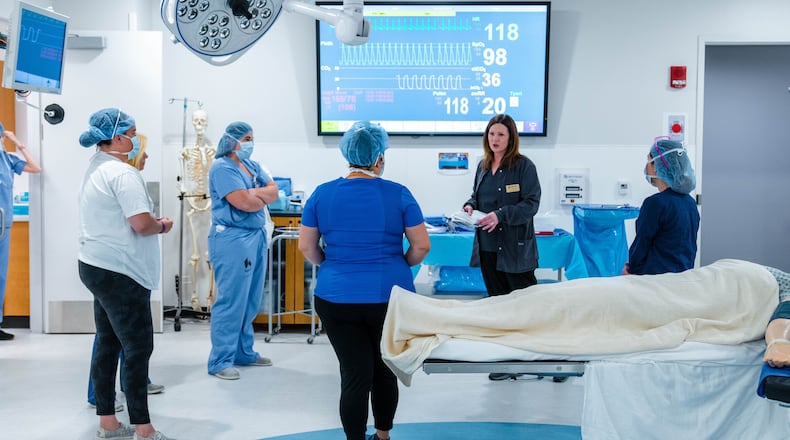“Sinclair’s Simulation Center aligns with the college’s mission to find the need and endeavor to meet it by providing vital hands-on training for our hospital and health care partners in a dedicated, state-of-the-art learning space,” said James Warden, senior manager of Sinclair Community College Workforce and Organizational Development.
Those hospital or other health care partners can lease the space or have Sinclair facilitate or develop the scenarios being tested out in the center. They can create scenarios for specific training purposes including mock code situations, difficult airway cases, pediatric emergencies, and more.
Health science programs will use also that space, which houses a variety of equipment to depict operating rooms, home health care areas, and exam rooms.
“There’s four dedicated simulation rooms in the actual Simulation Center, but what we also consider part of the health science buildings, we have a dedicated OR suite. We have an apartment where we can do home health, caregiver training, as well as standardized patient care area.”
The Simulation Center is located in Sinclair’s Ned J. Sifferlen Health Sciences Center at the Dayton campus, which the college dedicated in 2017 and moved almost all of their health sciences programs to under one roof. Part of the mission of the building was to have it be a resource for community partners, like health care organizations, Warden said.
Sinclair began working with health care partners in late 2019 as part of this initiative to provide this opportunity for workforce development at the Simulation Center, but then they paused during the COVID-19 pandemic.
Three years later, the center is ramping back up efforts to provide opportunities for training, on-boarding scenarios for staff, competency assessments, or other scenarios to work with and prepare current professionals.
“We’ve got the resources so we can always have the most up to date technology,” Warden said. Health care organizations also don’t need to tie up of their own facilities for training but using the Simulation Center. “Everyone that I’ve ever brought through the actual health science center and the simulation space has been blown away.”
Recently, the Simulation Center has worked with health care workers on scenarios like practicing inserting air tubes through a difficult air pathway, as well as another that assessed use of personal protective equipment and found contamination risks when workers did not stick to PPE protocol.
“We’ve also done a mock code, so this would be like either a respiratory arrest or a cardiac arrest,” Warden said. Workers can practice the team dynamic of that type of situation.
They have also practiced the management of an ICU patient with a critical care simulator that is “as close to a human as you can possibly get,” Warden said. The simulator will respond with physiological changes depending on the choices made.
“Our partnership with Sinclair and their simulation lab has exceeded our expectations. From our first session, we saw a difference in the way the teams interacted and processed critical situations. This partnership has helped our leaders multiply their efforts and gain sustained results,” said Erica Schneider, chief operating officer at the Kettering Health Main Campus.
Staff from Life Connection of Ohio also were able to practice a scenario using a simulation on a mechanical ventilator to complete their physical assessment competency training, said Laci Baker, recovery service manager at Life Connection of Ohio.
“The staff really enjoyed the Sinclair Simulation Center atmosphere and appreciated having the ability to play out a realistic donor management scenario in a life-like ICU setting,” Baker said.
“Sinclair Community College is proud to provide high quality simulation-based learning experiences for our students and current healthcare professionals. Sinclair’s facilities mirror the environments of the region’s hospitals and utilize human-patient simulators to maximize learning,” added Dr. Rena Sebor, dean of Sinclair Community College Health Sciences Division.
How to get involved
Hospitals and health care facilities who are interested in utilizing Sinclair’s Simulation Center can contact James Warden with Sinclair’s Workforce Development Division at 937-512-2235 or james.warden@sinclair.edu.
About the Author


